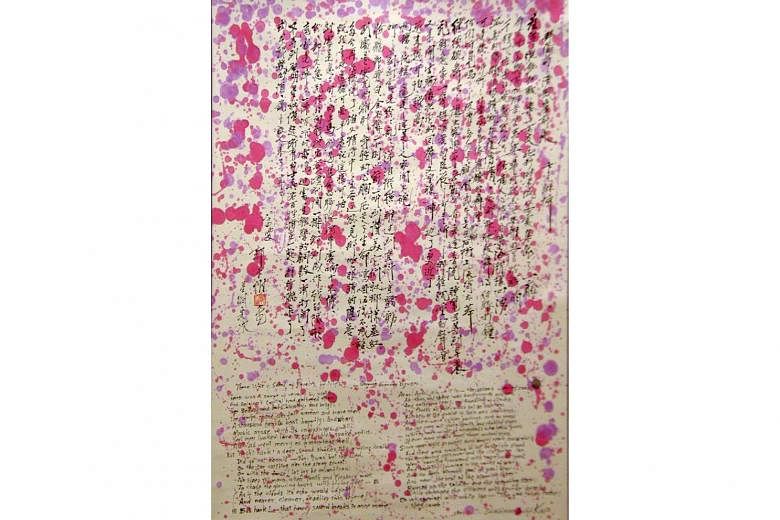Chinese Ink Works from Lee Kong Chian Collection of Chinese Art at the NUS Museum presents classical ink works from the Qing dynasty period as well as more recent Chinese ink works and paintings by artists from Singapore and Malaysia.
Poem Of Byron In Running Script Calligraphy (2001)
By David Kwo Da-wei
Ink on paper, 91x61cm
The work, which uses a translation of Lord Byron's poem, The Eve Of Waterloo, is an example of the contemporary expression of Chinese ink art, made in Kwo's trademark
colourful abstract style.
It is a form of bilingual calligraphy, an indication of the artist's journey from China through New York, as well as Singapore's own multiculturalism.

Calligraphy In Cursive Script (1982)
By Reverend Song Nian
Ink on paper, 105.5x30 cm
The late monk and artist Song is one of Singapore's calligraphy masters. In this work, he translates a poem by China's Reverend Ji Chan, which ends with an imagery of bamboo leaves, onto paper. He changed the words to reflect a local landscape instead by ending the poem with "the rustle of banana leaves".

Woman Selling Fruits (1971)
By Tan Kian Por
Ink and colour on paper, 105.9x78.8cm
China-born artist and alumni of the Nanyang Academy of Fine Arts Tan is renowned for his Nanyang- style artworks. This painting displays the hallmarks of the style, with its tropical and multicultural subject matter.

Three Fruits Of Nanyang (1966)
By Huang Baofang
Ink and colour on paper, 68x44cm
As a member of The Society of Chinese Artists in Singapore, Huang's art sought to spread the principles of modernity related to China's May Fourth movement in a localised way. In this painting, Huang rifts on the traditional theme of the "three friends" in Chinese painting - bamboo, pine and plum - by using tropical fruits durian, rambutan and mangosteen instead.

Landscape (1970s)
By Chan Yim Man
Ink and colour on paper, 60x41cm
Chan was one of the founding members of One Art Group, a Hong Kong-based art group that was very active in the 1970s. The members of the group presented Chinese ink painting in a contemporary manner.

Colour Calligraphy: Tranquil Heart (circa 2000)
By Lim Tze Peng
Ink and colour on paper, 106x106cm
The artist's colour calligraphy series demonstrates how the form evolved from classical practice relying mainly on canonical scripts into a more free-spirited contemporary form.
This is similar to how classical ink and brush techniques were used in a modern way in South-east Asian landscapes.

Trees (2010)
By Lim Tze Peng
Ink and colour on paper, 241x490 cm
While Lim created new calligraphic styles which are unrestrained by form and involve freestyle strokes, he returned to a familiar subject matter - that of trees and wooded paths, which he developed a fondness for during his trips to Bali and other parts of South-east Asia.
WHERE: Lee Kong Chian Gallery, NUS Museum, University Cultural Centre, 50 Kent Ridge Crescent, National University of Singapore MRT: Clementi WHEN: Ongoing, 10am to 7.30pm (Tuesday to Friday); 10am to 6pm (weekend); closed on Monday and public holiday ADMISSION: Free INFO: museum.nus.edu.sg
Nabilah Said

